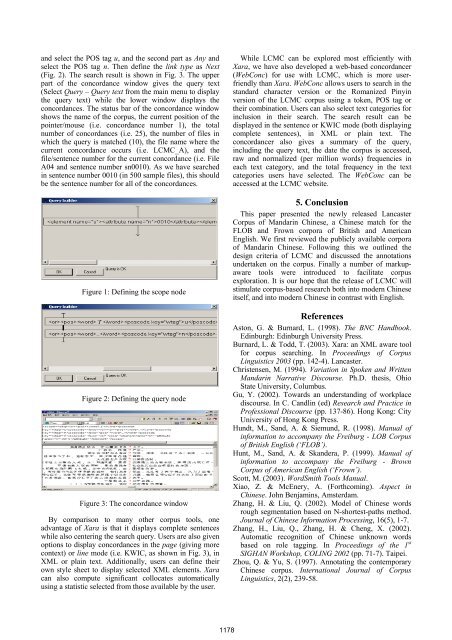The Lancaster Corpus of Mandarin Chinese: A Corpus for ...
The Lancaster Corpus of Mandarin Chinese: A Corpus for ...
The Lancaster Corpus of Mandarin Chinese: A Corpus for ...
Create successful ePaper yourself
Turn your PDF publications into a flip-book with our unique Google optimized e-Paper software.
and select the POS tag u, and the second part as Any and<br />
select the POS tag n. <strong>The</strong>n define the link type as Next<br />
(Fig. 2). <strong>The</strong> search result is shown in Fig. 3. <strong>The</strong> upper<br />
part <strong>of</strong> the concordance window gives the query text<br />
(Select Query – Query text from the main menu to display<br />
the query text) while the lower window displays the<br />
concordances. <strong>The</strong> status bar <strong>of</strong> the concordance window<br />
shows the name <strong>of</strong> the corpus, the current position <strong>of</strong> the<br />
pointer/mouse (i.e. concordance number 1), the total<br />
number <strong>of</strong> concordances (i.e. 25), the number <strong>of</strong> files in<br />
which the query is matched (10), the file name where the<br />
current concordance occurs (i.e. LCMC_A), and the<br />
file/sentence number <strong>for</strong> the current concordance (i.e. File<br />
A04 and sentence number sn0010). As we have searched<br />
in sentence number 0010 (in 500 sample files), this should<br />
be the sentence number <strong>for</strong> all <strong>of</strong> the concordances.<br />
Figure 1: Defining the scope node<br />
Figure 2: Defining the query node<br />
Figure 3: <strong>The</strong> concordance window<br />
By comparison to many other corpus tools, one<br />
advantage <strong>of</strong> Xara is that it displays complete sentences<br />
while also centering the search query. Users are also given<br />
options to display concordances in the page (giving more<br />
context) or line mode (i.e. KWIC, as shown in Fig. 3), in<br />
XML or plain text. Additionally, users can define their<br />
own style sheet to display selected XML elements. Xara<br />
can also compute significant collocates automatically<br />
using a statistic selected from those available by the user.<br />
While LCMC can be explored most efficiently with<br />
Xara, we have also developed a web-based concordancer<br />
(WebConc) <strong>for</strong> use with LCMC, which is more userfriendly<br />
than Xara. WebConc allows users to search in the<br />
standard character version or the Romanized Pinyin<br />
version <strong>of</strong> the LCMC corpus using a token, POS tag or<br />
their combination. Users can also select text categories <strong>for</strong><br />
inclusion in their search. <strong>The</strong> search result can be<br />
displayed in the sentence or KWIC mode (both displaying<br />
complete sentences), in XML or plain text. <strong>The</strong><br />
concordancer also gives a summary <strong>of</strong> the query,<br />
including the query text, the date the corpus is accessed,<br />
raw and normalized (per million words) frequencies in<br />
each text category, and the total frequency in the text<br />
categories users have selected. <strong>The</strong> WebConc can be<br />
accessed at the LCMC website.<br />
5. Conclusion<br />
This paper presented the newly released <strong>Lancaster</strong><br />
<strong>Corpus</strong> <strong>of</strong> <strong>Mandarin</strong> <strong>Chinese</strong>, a <strong>Chinese</strong> match <strong>for</strong> the<br />
FLOB and Frown corpora <strong>of</strong> British and American<br />
English. We first reviewed the publicly available corpora<br />
<strong>of</strong> <strong>Mandarin</strong> <strong>Chinese</strong>. Following this we outlined the<br />
design criteria <strong>of</strong> LCMC and discussed the annotations<br />
undertaken on the corpus. Finally a number <strong>of</strong> markupaware<br />
tools were introduced to facilitate corpus<br />
exploration. It is our hope that the release <strong>of</strong> LCMC will<br />
stimulate corpus-based research both into modern <strong>Chinese</strong><br />
itself, and into modern <strong>Chinese</strong> in contrast with English.<br />
References<br />
Aston, G. & Burnard, L. (1998). <strong>The</strong> BNC Handbook.<br />
Edinburgh: Edinburgh University Press.<br />
Burnard, L. & Todd, T. (2003). Xara: an XML aware tool<br />
<strong>for</strong> corpus searching. In Proceedings <strong>of</strong> <strong>Corpus</strong><br />
Linguistics 2003 (pp. 142-4). <strong>Lancaster</strong>.<br />
Christensen, M. (1994). Variation in Spoken and Written<br />
<strong>Mandarin</strong> Narrative Discourse. Ph.D. thesis, Ohio<br />
State University, Columbus.<br />
Gu, Y. (2002). Towards an understanding <strong>of</strong> workplace<br />
discourse. In C. Candlin (ed) Research and Practice in<br />
Pr<strong>of</strong>essional Discourse (pp. 137-86). Hong Kong: City<br />
University <strong>of</strong> Hong Kong Press.<br />
Hundt, M., Sand, A. & Siemund, R. (1998). Manual <strong>of</strong><br />
in<strong>for</strong>mation to accompany the Freiburg - LOB <strong>Corpus</strong><br />
<strong>of</strong> British English (‘FLOB’).<br />
Hunt, M., Sand, A. & Skandera, P. (1999). Manual <strong>of</strong><br />
in<strong>for</strong>mation to accompany the Freiburg - Brown<br />
<strong>Corpus</strong> <strong>of</strong> American English (‘Frown’).<br />
Scott, M. (2003). WordSmith Tools Manual.<br />
Xiao, Z. & McEnery, A. (Forthcoming). Aspect in<br />
<strong>Chinese</strong>. John Benjamins, Amsterdam.<br />
Zhang, H. & Liu, Q. (2002). Model <strong>of</strong> <strong>Chinese</strong> words<br />
rough segmentation based on N-shortest-paths method.<br />
Journal <strong>of</strong> <strong>Chinese</strong> In<strong>for</strong>mation Processing, 16(5), 1-7.<br />
Zhang, H., Liu, Q., Zhang, H. & Cheng, X. (2002).<br />
Automatic recognition <strong>of</strong> <strong>Chinese</strong> unknown words<br />
based on role tagging. In Proceedings <strong>of</strong> the 1 st<br />
SIGHAN Workshop, COLING 2002 (pp. 71-7). Taipei.<br />
Zhou, Q. & Yu, S. (1997). Annotating the contemporary<br />
<strong>Chinese</strong> corpus. International Journal <strong>of</strong> <strong>Corpus</strong><br />
Linguistics, 2(2), 239-58.<br />
1178
















